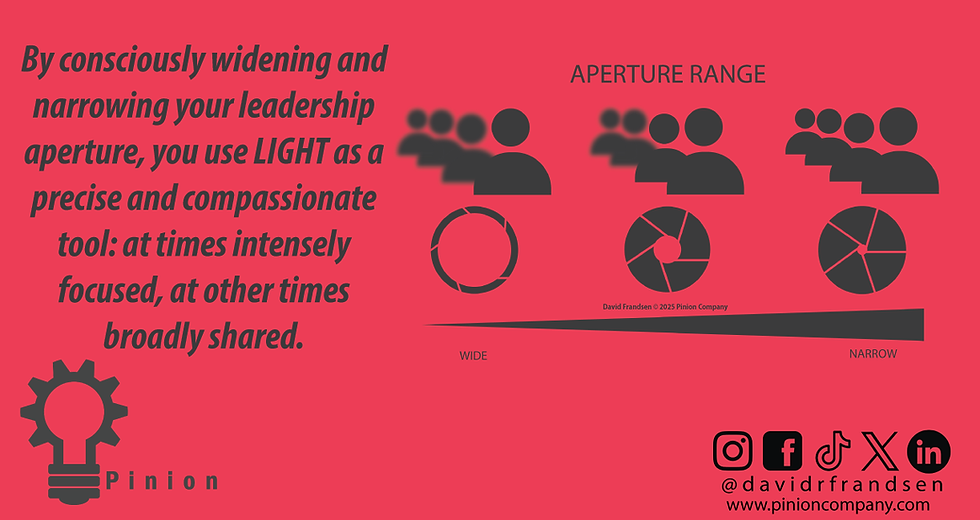Planting Trees Knowing You’ll Never Sit in their Shade
- David Frandsen
- Sep 28
- 3 min read

There’s a phrase that has guided me through my entire career: plant trees knowing you’ll never sit in their shade. For me, this isn’t just a nice metaphor—it’s a lens through which I see the impact of leadership and administration. So much of what we pour ourselves into, whether as employees, administrators, or leaders, won’t directly benefit us. But it will shape the future for those who come after us.
Early in my career, when I first took over the inspection duties, I faced an uphill battle. The water system maps were often inaccurate, a constant source of frustration for me and my coworkers. Complaints were common, and I shared them. Why were those maps so bad? It wasn’t just because it was hard work. It was due to lack of staffing, a lack of technology—before GPS was widely available—and at times, a lack of effort to ensure the work was complete and accurate. But most importantly, it was about the absence of deliberate intention around future-proofing that work.
From day one, I made it my goal to fix those inaccuracies. Every pipe, every valve that went into the ground needed GPS coordinates, photos, depths, and detailed notes. I wanted future employees to have the tools and information that I wished I had. I imagined them thanking me instead of cursing my predecessors who hadn’t put in the same care. That effort was my way of planting a tree: I knew I wouldn’t rest in its shade, but I hoped others would.
This experience ties directly into what I called the “Public Works Iceberg.” So much of the work we do happens beneath the surface—unseen, unrecognized, but absolutely essential. Like an iceberg, you only glimpse a small visible portion of what keeps a city running. The rest—the planning, the repairs, the maintenance, and yes, the leadership required to keep all those pieces aligned—is hidden below. It’s a reminder that the best work is often quiet and invisible until years later when it compounds and grows, finally showing its beauty and providing shade.
Leadership itself is like that iceberg. The public or even your team sees surface-level decisions and results, but the mentoring, teaching, honest conversations about weaknesses, and the humility required to grow are deep underwater. Early in my leadership journey, I found it strange, even uncomfortable, to talk about leadership deliberately. I wasn’t perfect—far from it. I didn’t have all the answers, and that feeling hasn’t changed. But I learned that leadership isn’t about perfection. It’s about being intentional, reflective, and courageous enough to admit blind spots and growth areas.
That awareness led me to develop the Planetary Gear Model. Just like in an actual planetary gear system, where multiple gears share the load and ensure smooth operation, leadership is shared and distributed. No single gear carries all the weight. For me, this model helps pinpoint weaknesses and blind spots in leadership—that’s where we need the most attention. And it reminds me that great leadership is fundamentally about growing other leaders who contribute their unique strengths, helping the entire system mesh and thrive.
Being deliberate about growing people and leaders is one of the highest callings of leadership. Mentoring, sharing knowledge, and fostering an environment where others can step up and lead is how legacy is truly built. This work is often unglamorous and slow to show results, just like planting trees. But over time, those small efforts compound, building resilient, effective teams and cultures that outlast any individual.
The greatest satisfaction as a leader isn’t from the applause or recognition. It’s seeing those you’ve mentored carry the work forward, nurturing and growing what you started. Like a forest, the shade and beauty of leadership multiply far beyond the planter’s lifetime. My hope is that future leaders, those who worked alongside me and those yet to come, will continue to care for this legacy—adding their own branches, and providing comfort and inspiration for many yet to live in that shade.
So whether it’s fixing a water map, mentoring a hesitant new leader, or making a tough decision, I remind myself to plant thoughtfully and tend carefully, knowing I’m part of a much bigger picture. We may never sit under the trees we plant. But those trees—our work, our people, our leadership—will shade others for generations to come.




Comments